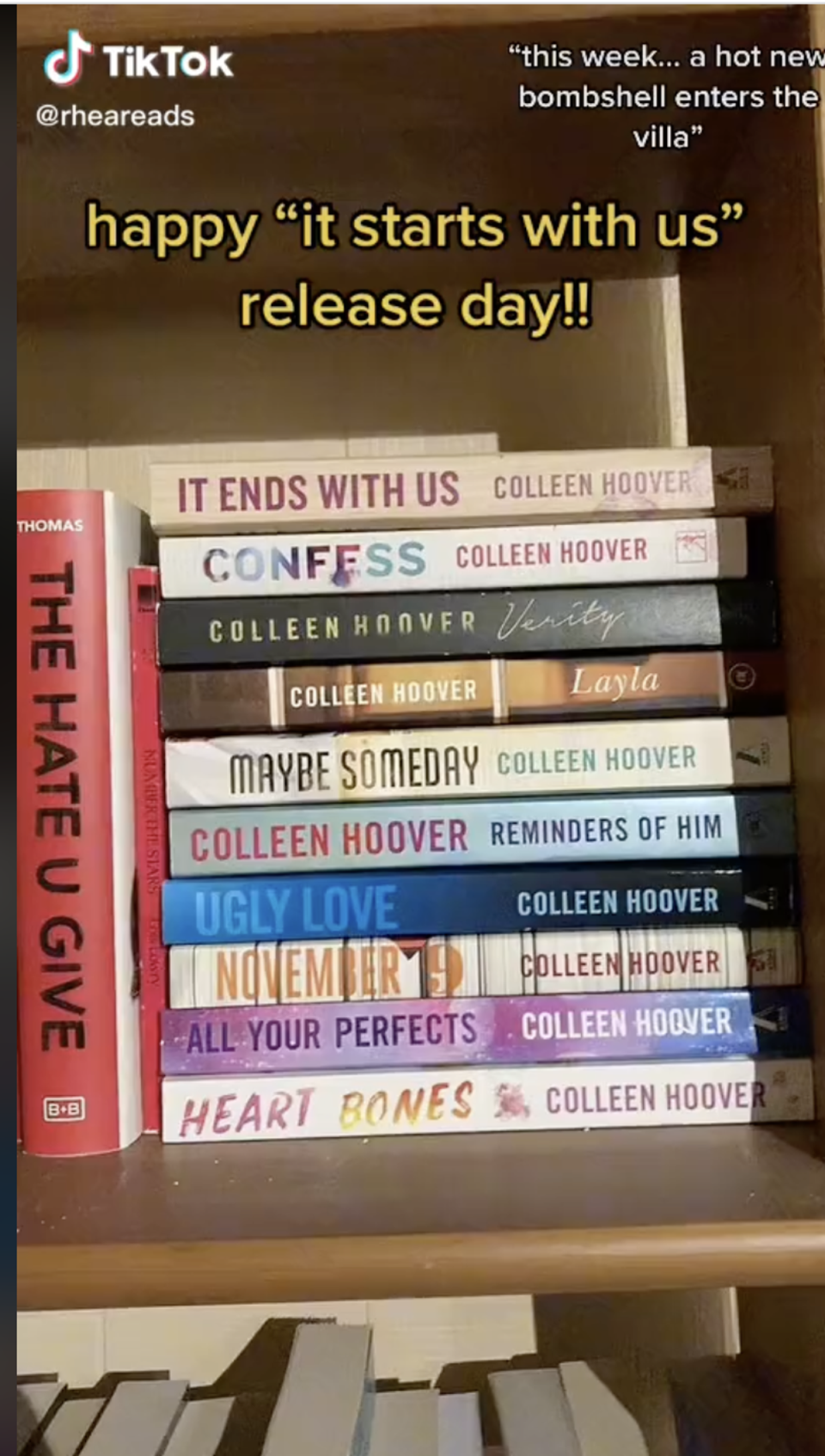CoHort, assemble: How Colleen Hoover became the world’s biggest author

Colleen Hoover is the reigning queen of #BookTok. But chances are, if you’ve never heard her name before, that distinction will do little to clear things up. It’s TikTok’s literary corner, where millions of readers share their “To Be Read” piles and author “Top 5” reveals. And it’s characterised by zealous devotion to a handful of authors. Here, the prolific scribe of steamy romance novels has a cloying celeb nickname – “CoHo” – and a cultishly devoted fan hive – her “CoHort”.
Which isn’t to say Hoover’s appeal is niche. Right now, she’s the author of five of the top 12 fiction books on the New York Times bestseller list, and eight of the top 12 books in paperback. Her back catalogue – nearly 30 titles published or self-published in the last 10 years – is eclectic. The former social worker from Texas mostly writes adult romance, but her first book Slammed, in 2012, was for young adults. Since then she’s done sequels, thrillers, and even a ghost story, Layla.
There are through-lines, of course. Hoover returns to themes of domestic violence and sexual assault. And her heroines usually find a hard-earned happy ending, the kind that keeps readers reaching for the next CoHo title on their TBRs. She’s this moment’s answer to Danielle Steel, minus the wealthy socialites in crisis.
It’s for her affectionately greedy fans specifically that she’s written her latest, It Starts with Us, a follow-up to her mega-selling 2016 novel It Ends with Us, which has sold 4 million copies so far. In her new release’s acknowledgements, Hoover, 42, calls Ends – the story of a young florist who finds herself in an abusive marriage – “the one book I have been adamant I would never write a sequel for”.
But then things got out of control. On a corner of TikTok where the hashtag #ColleenHoover has been viewed 2.4 billion times, readers begged for more. And I can see why – beyond the dollar signs – the CoHort’s passion was convincing. Their pleas were intense and personal. “I’m just about to go hit rock bottom.” “This book destroyed me mentally.” “The absolute devastation I felt.” On social media, Hoover’s readership is locked in a bombastic battle over who is the most vicariously pummelled by what she’s written.
If it weren’t for Hoover’s staggering sales, you likely wouldn’t perceive anything remarkable in her prose (unadorned) or plot twists (simply wild). She’s got the romance writer’s habit of assigning her inventions improbably apt names. The love triangle around which It Starts with Us revolves is composed of the aforementioned florist, called Lily Bloom, her violent ex-husband Ryle, and a charismatic chef who’s drifted in and out of Lily’s life, whose name is Atlas. Hoover’s more descriptive flourishes can be confusing. “My throat is so thick with burgeoning tears,” she writes in one medically concerning episode. Her characters compose a lot of letters to each other, occasionally (and inexplicably) when they’re sitting side by side.
Some of the praise that’s been heaped on Hoover’s writing takes the form of literary negging: characters so bland that readers can project themselves into the action, or sentences so plain that they don’t distract from it. But to get bogged down in what’s “wrong” with the book – which happens plenty on BookTok, where Hoover also has a chorus of detractors – is to miss out on the more fascinating question about It Ends with Us: what’s made it so insanely popular anyway?
The so-called “trauma plot” – by this I mean stories in which the forward action is inextricably linked to some terrible event, such as a rape, a miscarriage, or childhood abuse – has come under criticism of several kinds lately. It’s a storytelling technique Hoover makes frequent use of. In Layla, the protagonist is the victim of a near-fatal attack. In Ends, there’s intimate partner abuse and several kinds of childhood trauma.
In Hoover’s romantic worlds, trauma is validated, healing is possible, and people – even irredeemable villains – can at least be understood
The trauma-centred plot has limits. It burdens the novel with a kind of emotional stasis. It reduces characters to their backstories. But it’s also exploded in popularity, alongside the use of therapeutic language in regular conversation – something that Hoover’s books shrewdly reflect.
This reliance on a character’s backstory means Hoover’s narratives sometimes lack subtlety. For example, a hero’s detachment turns out to be a coping mechanism because of a horrendous experience. But this logic also brings a buoying sense of optimism to even her bleakest stories. If a person’s character is a reflection of what’s happened to her, then what happens next can change everything. Experiences are constitutive, and stories of wretched despair take on the slant of hope. In Hoover’s romantic worlds, trauma is validated, healing is possible, and people – even irredeemable villains – can at least be understood.

It helps, too, that not every component of Lily’s life is hard at once. In It Starts with Us, she has a harassing ex-husband, but an attentive boyfriend. She’s exhausted, but her helpful family lives nearby. It’s a book about the aftermath of abuse, but not loneliness. Lily has community. Even Ryle’s family takes her side. Hoover’s said she based the tragic events of Lily’s marriage on her own mother’s experiences. That so many BookTokers wish aloud for the novel to come with a “trigger warning” suggests they bring their own experiences of trauma, either personal or of those close to them, to the narrative.
Hoover gets that. In a letter that welcomes readers into the pages of Starts, she calls the dark narrative of Ends “empowering”. Then she gives the CoHort the anti-trigger warning of their dreams. “This novel was written as a thank-you for the tremendous support, and because of that, I wanted to deliver a much lighter experience. Lily and Atlas deserve it.” Just like that, her most successful novel to date becomes 300 pages of backstory.
